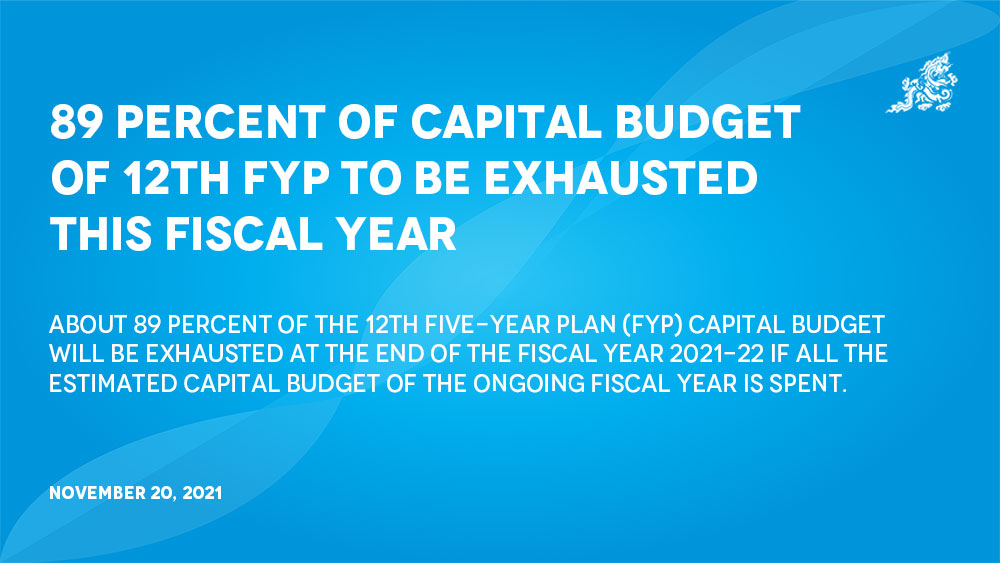MB Subba
About 89 percent of the 12th Five-Year Plan (FYP) capital budget will be exhausted at the end of the fiscal year 2021-22 if all the estimated capital budget of the ongoing fiscal year is spent.
The actual capital expenditure of the first three fiscal years and the budget estimates of the fourth year of the 12th FYP amounts to Nu 103.68 billion (B), according to figures with the Ministry of Finance.
In other words, only Nu 12.44B or 11 percent of the capital budget will be left for the fiscal year 2022-23, which will be the fifth year of the 12th FYP and the final year of the present government.
Finance Minister Namgay Tshering acknowledged that not much of the budget is left for the next fiscal year. However, he claimed that the scenario signified the government’s efficiency in the utilisation of the budget.
“We have invested the money within four years, instead of five years. This only proves our efficiency,” he said.
He said that the early exhaustion of the budget was a result of the government’s expansionary fiscal policy after the imposition of Covid-19 restrictions in March 2019.
“We don’t have the luxury of wasting time and being stingy. We could be left behind with many countries of similar size when the world economies recover from the pandemic in a few years,” the finance minister said.
Lyonpo Namgay Tshering said that the scenario has also emerged due to the frontloading exercise. He said government spending needed to be ramped up to mitigate the economic impact of the pandemic.
According to him, the nominal GDP loss incurred in six months of 2020 amounted to Nu 5B and the government needed to pump money into the economy to offset the loss.
He said that government spending, which is one of the major drivers of the economy, contributed about 38 percent of the GDP.
Lyonpo Namgay Tshering highlighted the possibilities of programmed borrowings to meet the expenditure of the remaining years. The borrowings, he said, could be injected into activities that face budget shortages.
“If we have to revive the economy and position the country on the path to recovery, we have to invest, not spend,” he said. However, he added that no plans have been finalised on borrowings, “although some people have started pre-empting.”
Lyonpo Namgay Tshering said that the budget in the first and final years of the government would be minimal as they coincide with the transition periods.
According to him, the government has been able to utilise the budget despite the pandemic.
He said the physical and financial achievements of gewogs were 95 percent and 98 percent respectively, and that the expenditures of central agencies were similar.
However, an opposition member said that the achievements in infrastructure development did not match the expenditure. He said that the budget could have been used much more fruitfully.
The projected fiscal deficit of the 12th FYP was Nu 29B, which according to the finance minister, had been reduced through the government’s efforts to mobilise funds. He said that the government had mobilised Nu 6B through grant programmes.
The overall expenditure (capital and current) at the end of the current fiscal year would be 75 percent, according to the ministry’s estimates.
A total of Nu 128.207B or 66 percent of the total current budget will be utilised at the end of the current fiscal year. In other words, Nu 65B will remain as a current expenditure.
The total budget for the 12th FYP is Nu 310B.
The finance minister said that the government has been receiving funds from development partners as per the commitments despite the pandemic’s impact on the world economy.
In total, Bhutan’s development partners have committed about USD 865 million (M), which is equivalent to Nu 63B for the 12th FYP.
The government received a total of Nu 31B, which is almost half of the total development partners’ support for the 12th FYP, at the end of the first half of the five-year period in December 2020, according to a government document.
The figures show that despite the pandemic, the capital budget was spent much faster in the 12th FYP than in the 10th and 11th Plans.
The capital budget for the ongoing fiscal year has been revised as Nu 39.578B, according to the Department of National Budget.
Edited by Tashi Dema


